Abstract
In addition to its potential for wave power, wind power, hydropower, and solar power, it can be said that Vietnam is a country with great potential for biomass energy derived from agricultural waste, garbage, and urban wastewater, which are resources widely available across the country. This huge amount of biomass, however, if left untreated, could become a major source of pollution and cause serious impacts on ecosystems (soil, water, and air), as well as on human health. In this research, the authors present a fuzzy multicriteria decision-making model (FMCDM) for optimizing the site selection process for biomass power plants. All of the criteria affecting location selection are identified by experts and literature reviews; in addition, the fuzzy analytic hierarchy process (FAHP) method was utilized so as to identify the weight of all of the criteria in the second stage. Furthermore, the Technique for Order Preference by Similarity to an Ideal Solution (TOPSIS) is applied for ranking potential locations in the final stage of this research. As a result, Long An (DMU/005) was found to be the best location for building biomass energy in Vietnam. The main contributions of this work include modeling the site selection decision process under fuzzy environment conditions. The proposed approaches also can address the complex problems in site selection; it is also a flexible design model for considering the evaluation criteria, and is applicable to location selection for other industries.
1. Introduction
In the context of increasingly depleting domestic fossil fuels, rising world oil prices, and increasing reliance on world energy prices, the ability to meet energy requirements for domestic demand is increasingly becoming difficult, as well as a major challenge. Thus, considering that the exploitation of clean renewable energy (RE) has important meaning in terms of economy, society, food security, and sustainable development, the energy demand in Vietnam has increased at twice the rate of the gross domestic product (GDP) growth, while this rate is only approximately 1% in developed countries. Vietnam’s energy consumption has increased four times since 2005. From 1998 to 2008, the total electricity consumption demand in Vietnam increased by about 400% compared with the prior period. If this trend continues, Vietnam will become an energy importer in the future [1]. Vietnam’s power transmission system includes voltage levels of 500, 220, and 110 kV. A power transmission system of 500 KV with a total length of 4670 km from north to south facilitates the transmission of electricity exchange among the north, central, and south of Vietnam. Circuit 1 of the 500-kV line was put into operation in September 1994, while Circuit 2 was put into operation in late 2005. Although the power distribution system is in relatively good condition, it still has high power loss. Overloaded lines, transformers operating with low efficiency, and poor-quality cables are the main causes of high losses [2].
In addition to the potential for wave power, wind power, hydropower, and solar power, it can be said that Vietnam is a country with great potential for creating biomass energy from agricultural waste, garbage, and urban wastewater, which are widely distributed across the country. This huge amount of biomass, however, if left untreated, will become a major source of pollution and continue to cause serious impacts on ecosystems (soil, water, and air), as well as on human health [1].
In recent years, interest in developing renewable energy technologies to replace fossil energy sources has increased globally, as fossil energy sources are in danger of depletion and fuel costs are increasing. Vietnam is a long-term agricultural country; furthermore, raw materials needed for producing biomass energy are about 118 million tons/year [3]. Vietnam has favorable natural conditions, such as a hot and humid climate, heavy rain, and fertile land; as a result, biomass grows quickly. Byproducts from agriculture and forestry are abundant and constantly increasing. However, these byproducts are typically considered natural waste, thus becoming more dangerous and causing environmental pollution. Therefore, Vietnam has many favorable conditions for developing biomass energy. Taking advantage of biomass energy will simultaneously provide energy for economic development and ensure environmental protection [3].
Vietnam’s impressive economic reform over the past two decades has been accompanied by a sharp increase in energy demand. The Vietnamese government’s strategy is to ensure sustainable economic growth in the future. Therefore, the Vietnamese government has set renewable energy development targets, including those for solar energy, wind energy, and biomass energy. Biomass energy is targeted to achieve 2.1% of the total electricity output by 2030 [4].
As an agricultural country, Vietnam has great potential to develop biomass energy. Accordingly, the ability to sustainably exploit biomass for energy production in Vietnam is about 150 million tons/year [5]. The main types of energy biomass include wood, waste byproducts from crops, livestock waste, municipal waste, and other organic waste. Sources of renewable energy can be burned directly or be used to create biomass fuel pellets [5]. Currently, on the global scale, biomass is the fourth-largest energy resource, accounting for 14%–15% of the world’s total energy consumption. In developing countries, biomass is often the largest energy resource, averaging about 35% of the total energy supply [6].
One of the most important activities of the biomass energy project is site selection for building plants. A good location of a biomass plant is of vital importance for the project’s economic survival, and it includes solving complex location and transportation problems. In this research, we propose an MCDM model for biomass power plant location selection in Vietnam. All of the criteria affecting the location selection are identified by experts and literature reviews; furthermore, the fuzzy analytic hierarchy process (FAHP) method was utilized in order to identify the weight of all of the criteria in the second stage. TOPSIS was applied for ranking the potential locations in the final stage of this research. The general flow of the MCDM model is shown in Figure 1.

Figure 1.
General flow of multicriteria decision-making model (MCDM) model [7,8].
The primary goal of this research is to propose a useful fuzzy MCDM model for biomass power plant location selection. The proposed approaches can also address different complex problems in site selection; in addition, it is also a flexible design model for considering the evaluation criteria, and it is applicable to location selection for other industries.
The remainder of the research is to provide background to assist the authors in building the fuzzy MCDM model. Then, an integrated model using the FAHP–TOPSIS approach is introduced so as to select the best site for biomass power plant from eight potential locations in Vietnam. The results and contributions will be presented at the end of this paper.
2. Literature Review
Nowadays, there are many studies that have applied the MCDM model to select locations in the energy sector and some other industries, such as Roghayeh Ghasempour et al. [9], who have reviewed an application of the MCDM model for solar plant location selection and technology. In this paper, a wide variety MCDM methods, investigated by various researchers, are presented so as to obtain effective criteria for selecting solar plant sites and solar plant technologies. C. Chen et al. [10] proposed an optimization model for biomass location selection. In this research, the number of biomass power plants, optimum site, and transportation schemes were obtained with minimum cost, minimum energy consumption, and the lowest effect on the environment. Jakkawan Patomtummakan et al. [11] presented a mixed-integer linear programming for biomass power plant location selection. The objective of the optimization model is to minimize the total cost at selected bio-power plants by considering four cost components, namely, the fixed opening of the proposed bio-power plants, the material cost from purchasing biomass, the transportation cost between suppliers and bio-power plants, and the inventory holding cost.
Massimiliano Cattafi et al. [12] proposed an integer linear programming approach for defining the energy and cost-efficient biomass plant location, along with the corresponding provisioning basin. This optimization tool is just a small part of a wider perspective that is aimed at defining the decision support tools for the improvement of regional planning and its precise strategic environmental assessment. Heesung Woo et al. [13] integrated a multi-criteria analysis (MCA) and geographical information systems (GIS) for optimizing the site of the biomass energy plants. The research results show that land use, resource availability, and supply chain cost data can be integrated and mapped using GIS, in order to facilitate the determination of different sustainable factors weightings, and to ultimately generate optimal candidate sites for biomass energy plants.
Hao Lv et al. [14] proposed a multi-objective mixed-integer programming approach to solve the location selection issue for a straw-based power generation plant with CO2 emissions. It is anticipated that this paper will make a contribution to the current scientific knowledge by presenting innovative approaches for the sustainable utilization of forest harvest residues as a resource for the generation of bioenergy in Tasmania. Wang et al. [15] applied an MCDM model for solid waste to energy plant location selection. Jin Su Jeong et al. [16] proposed a multicriteria GIS assessment with a weighted linear combination (WLC) to various disciplines, using suitable criteria to optimize a biomass facility location. This assessment could be used in studies to verify suitable biomass plant sites with corresponding geographical and spatial circumstances and available spatial data necessary in various governmental and industrial sectors. Ali Asghar Isalou et al. [17] proposed an integrated fuzzy logic and analytic network process (FANP) to locate a suitable location for the landfilling municipal solid waste generated in Iran. Their findings revealed that the integration of fuzzy logic and ANP can give a better idea compared with other models like AHP, fuzzy logic, and ANP (individually). Therefore, this model can be applied in site selection for landfill of other similar places.
Wang et al. [18] proposed an MCDM model for solar panel site selection in Vietnam. In this work, the authors applied a data envelopment analysis (DEA) model for the selection of potential locations, FAHP was used for determining the weight of sub-factors, and TOPSIS was applied for ranking potential options. Wang et al. [19] proposed an MCDM model for wind power plant location selection. This study resided in the evolution of a new model that is flexible and practical for a decision-maker for site selection in the energy sector. Abdolvahhab Fetanat et al. [20] proposed a hybrid MCDM model for offshore wind power plants location selection in Iran. The evaluation factors and this model could be used in other coastal cities for promoting the progress of integrated coastal management (ICM), towards the goal of sustainability. Mostafa Rezaei-Shouroki [21] proposed an MCDM model by using a hybrid data envelopment analysis (DEA), AHP, and fuzzy TOPSIS model for wind farm location selection. The purpose of this study is to prioritize and rank 13 cities of the Fars province in Iran in terms of their suitability for the construction of a wind farm.
Fahime Heidarzade et al. [22] applied a MCDM model for wind farm site selection in Iran. In this research, a step-wise weight assessment ratio analysis (SWARA) is employed to rank factor affects to wind power plant site, and the weighted aggregates sum product assessment (WASPAS) is utilized to evaluate the decision-making unit (DMU). Halil Ibrahim Cobuloglu et al. [23] proposed a MCDM model for biomass location selection. In this work, the authors used an FANP for identifying the weight of all of the criteria. Yasir Ahmed Solangi et al. [24] integrated Delphi and AHP and fuzzy TOPSIS for the ranking and selection of renewable energy resources. The study provides important insights related to the prioritizing of RE resources for electricity generation, and can be used to undertake policy decisions toward sustainable energy planning in Pakistan. Mohammad Alhuyi Nazari et al. [25] used a TOPSIS model for analyzing solar farm location selection. The primary aim of this paper is to select suitable sites for photovoltaic installation in Iran. S. Saelee et al. [26] applied a TOPSIS multi-criteria approach for biomass type selection for boilers. Babak Daneshvar Rouyendegh et al. [27] applied intuitionistic fuzzy TOPSIS in the location selection of wind power plants in Turkey. The main purpose of the TOPSIS method is to rank the alternatives in the worst way. The intuitionistic fuzzy set (IFS) is used to reflect the approval, rejection, and hesitation of decision makers by dealing with real life uncertainty, imprecision, vagueness, and linguistic human decisions. Choudhary et al. [28] used a hybrid MCDM model including a social, technical, economic, environmental, and political (STEEP), fuzzy AHP and TOPSIS model for thermal power plant location selection in India. The paper presents a more accurate, effective, and systematic decision support tool for decision makers to conduct the evaluation process and to select optimal locations for TPPs.
Based on the literature review and experts’ opinion, there are some factors that must be considered in the biomass power plant location selection process, such as economic, environmental, technical, and social-political factors, and there are many researchers who have applied the MCDM model to various fields of science and engineering—a trend that has been increasing for many years—but very few works have focused on this problem in a fuzzy environment.
3. Methodology
3.1. Research Development
Many researchers have applied the MCDM model to various fields of science and engineering, more so over the last few years. One field in the MCDM approach has identified location selection problems; thus, especially in the renewable energy sector, decision-makers have to evaluate both qualitative and quantitative criteria. Although some studies have reviewed applications of MCDM approaches in biomass power plant location selection, to the best of our knowledge, few works have focused on this problem in a fuzzy environment. This is why the authors proposed an MCDM model for optimizing location selection for biomass energy power plants in this study. There are three main steps in this research.
- Step 1:
- All of the criteria and subcriteria affecting the site evaluation and selection processes are determined based on experts and literature reviews.
The processes of the selection criteria are shown in Figure 2.
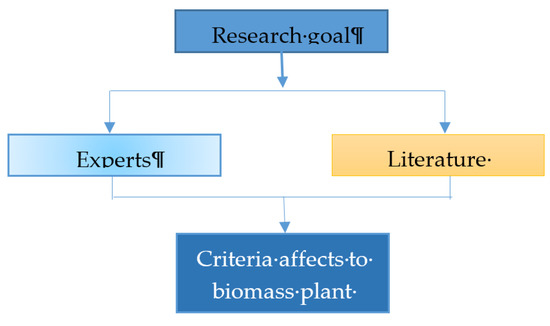
Figure 2.
Processes of selection criteria.
- Step 2:
- The FAHP model was utilized to identify the weight of all of the subcriteria in the second stage.
The FAHP method has many advantages compared with other multi-objective decision-making methods. First, many multicriteria decision-making methods face difficulties in determining the importance of each criterion, while FAHP is a well-known method of determining these weights. Therefore, FAHP can be combined with other easy methods to take advantage of each method in problem-solving. In addition, FAHP can check consistency in decision-makers’ judgment. Moreover, the hierarchical analysis process is easy to understand, considering many small criteria and analyzing all of the qualitative and quantitative factors.
- Step 3:
- The TOPSIS model is used for ranking potential locations in the final stage.
The advantages of the TOPSIS methods are simplicity, rationality, comprehensibility, good computational efficiency, and the ability to measure the relative performance for each alternative in a simple mathematical form. TOPSIS is based on the concept that the chosen alternative should have the shortest geometric distance from the positive ideal solution (PIS) and the longest geometric distance from the negative ideal solution (NIS). Diagram of research as shown in Figure 3.
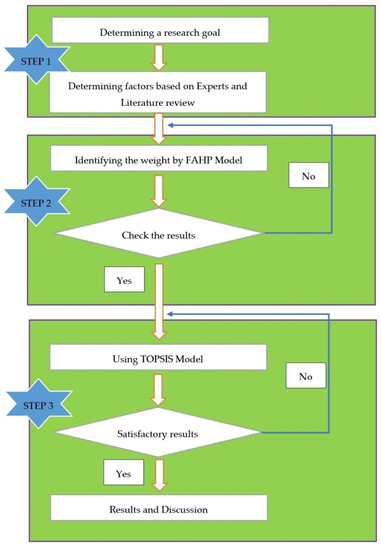
Figure 3.
Diagram of research. FAHP—fuzzy analytic hierarchy process.
3.2. Fuzzy Sets, AHP, and TOPSIS Model
3.2.1. Fuzzy Sets and Fuzzy Number
In 1965, Lotfi A. Zadeh published the article with the title “Fuzzy Set”, which describes the mathematics of “fuzzy set” and “fuzzy logic” theory. The triangular fuzzy number (TFN) can be defined as (g, p, s). TFNs are shown in Figure 4.
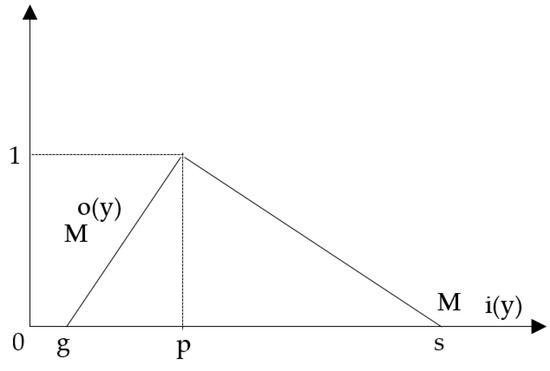
Figure 4.
Traingular fuzzy number.
TFN also can be defined as follows:
The representatives of each level of membership give a fuzzy number, as follows:
o(y), i(y) indicates both the left side and the right side of a fuzzy number, respectively, as follows:
3.2.2. Analytic Hierarchy Process (AHP) Model
AHP is presented by Saaty. AHP is an MCDM that simplifies complex problems by sorting criteria and options in a hierarchical structure. Let F = is a factor set. The pairwise comparison metrics on m criteria will be presented in an m × m evaluation matric (D). Every element, , is the quotient of the weights of the factors, as follows:
The relative priorities are given by the Eigenvector (l) corresponding to the largest eigenvector , as follows:
The consistency is determined by the relation between the entries of D and CI, as follows:
CR is calculated as the ratio of the CI and the RI, as shown in Equation (7):
CR value must less than (or equal) 0.1. If the CR >0.1, the evaluation needs to be repeated again for improving consistency.
3.2.3. Technique for Order Preference by Similarity to an Ideal Solution (TOPSIS)
TOPSIS assumes that we have m alternatives (options) and n attributes/criteria, and we have the score of each option with respect to each criterion.
- Construct the normalized decision matrixwith i = 1, 2, …, m; and j = 1, 2, …, n.
- Construct the weighted normalized decision matrixwith i = 1, 2, …, m and j = 1, 2, …, n.
- Determine the ideal and negative ideal solutions
- Calculate the separation measures for each alternativeoptions to NIS.
- Calculate the relative closeness to the ideal solution ()
4. Case Study
The total potential of Vietnam’s biomass energy source is more than 99 million tons/year, corresponding to the electric energy source of more than 340,000 GWh, of which the largest is the Mekong River Delta (Mekong Delta), accounting for 33.4%, followed by the North Central Coast and South Central Coast with 21.8% [29].
According to the Vietnam Institute of Energy, agricultural byproducts from the Mekong Delta amount for about 23 million tons/year, which includes about 3.8 million tons of rice husk, nearly 17 million tons of rice straw, over 372,000 tons of corn, and nearly 1.4 million tons of bagasse [30]. Thus, the authors proposed an MCDM model for optimizing location selection for biomass energy power plants in the Mekong Delta. In a renewable energy project, selecting a location to build a power plant includes complex decision-making, which includes economic, natural, and social factors. The material source of this project is rice husk. After preliminary studies, eight potential locations in the Mekong Delta (DMUs) were selected (see Table 1 and Figure 5).

Table 1.
A potential locations list. DMU—decision making unit.

Figure 5.
Mekong Delta map.
In the first stage of this work, the main factors and subcriteria affects on location selection are identified by experts and literature reviews. The general hierarchy structure of the proposed model is shown in Figure 6.
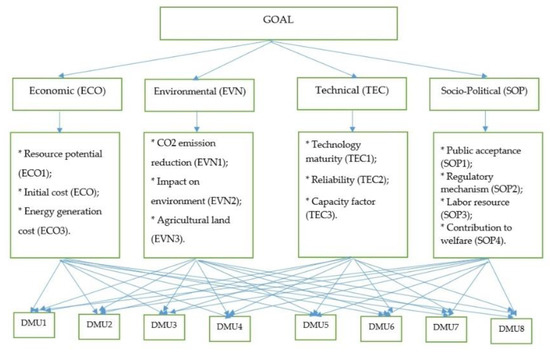
Figure 6.
General hierarchy structure of proposed model.
The fuzzy analytic hierarchy process (FAHP) method was utilized to identify the weight of all of the criteria in the second stage. The results are shown in Table 2.

Table 2.
Weight of all of the subcriteria. ECO—economic; EVN—environmental; TEC—technical; SOP—socio-political.
The TOPSIS is applied for ranking potential locations in the final stage of this research. The normalized matrix and normalized weight matrix are shown in Table 3 and Table 4, respectively.

Table 3.
Normalized matrix.

Table 4.
Normalized weight matrix.
Vietnam is a developing agricultural country and has great potential to create biomass sources for energy production. If effectively exploited, biomass energy will help reduce dependence on traditional power sources, reduce carbon emissions, reduce pollution, and bring direct profits to establishments; furthermore, farmers can participate in the biomass fuels supply chain via selling waste and agricultural byproducts. According to the calculation theory, the total potential of Vietnam’s biomass energy source is more than 99 million tons/year, corresponding to the electric energy source of more than 340,000 GWh, of which the Mekong River Delta (Mekong Delta) accounts for 33.4%, followed by the North Central Coast and Central Coast with 21.8% [31]. The primary goal of this research is to propose a useful fuzzy MCDM model for biomass power plant location selection. In the first stage of this work, all of the criteria affecting the location selection are identified by experts and literature reviews; in addition, the FAHP method was utilized to identify the weight of all of the criteria in the second stage. The TOPSIS is applied for ranking the potential locations in the final stage of this research; furthermore, TOPSIS is based on the concept that the chosen alternative should have the shortest geometric distance from the PIS and the longest geometric distance from the NIS. As per the results shown in Figure 7 and Table 5, Long An (DMU/005) is found to be the best location for building biomass energy in Vietnam.
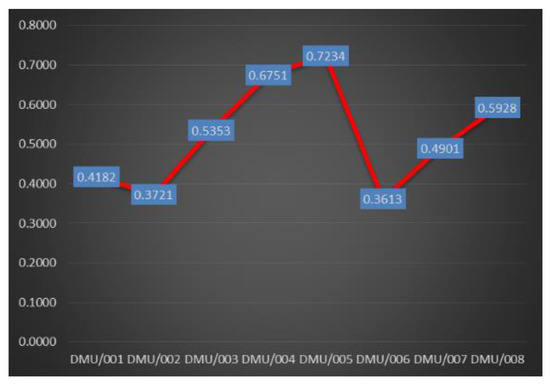
Figure 7.
Final ranking list.

Table 5.
Negative ideal solution (NIS) and positive ideal solution (PIS) values in the Technique for Order Preference by Similarity to an Ideal Solution (TOPSIS) model.
5. Conclusions
As an agricultural country, Vietnam is an ideal place for producing biomass energy. Agricultural waste is the most abundant in the Mekong Delta region, which makes up about 50% of the country. Major biomass resources include straw, rice husks from rice mills, bagasse from sugar mills, coffee husks from coffee-processing plants, and wood chips from wood-processing industries. Vietnam has set a target of a combined capacity of 500 MW of biomass energy by 2020, rising to 2000 MW by 2030 [32].
Therefore, Vietnam has many favorable conditions for developing biomass energy. Taking advantage of biomass energy will simultaneously provide energy for economic development, and ensure environmental protection. Although there are many studies in regard to developing methods and using different criteria for evaluating renewable energy location, research on biomass location evaluation and selection remains limited, especially in regard to the use of integrating economic and environmental criteria. In this research, the authors presented a fuzzy multicriteria decision-making model (FMCDM) for optimizing the site selection process for biomass power plants under fuzzy environment conditions. All of the criteria affecting location selection are identified by experts and literature reviews; in addition, the fuzzy analytic hierarchy process (FAHP) method was utilized to identify the weight of all of the criteria in the second stage. As a result, Long An (DMU/005) was found to be the best location for building biomass energy plants in Vietnam.
The main contribution of this work includes modeling the site selection decision process under fuzzy environment conditions. This paper also considers the evolution of a new model that is flexible and practicable to the decision-maker. This research also provides a useful guideline for biomass power plant location selection in many countries, as well as providing a guideline for location selection in related industries. Furthermore, for future research, the application of other MCDM approaches can be utilized so as to compare the results in the search of any changes.
Author Contributions
Conceptualization, C.-N.W., T.-T.T., and Y.-F.H.; formal analysis, C.-N.W. and Y.-F.H.; funding acquisition, C.-N.W.; methodology, T.-T.T.; project administration, C.-N.W. and Y.-F.H.; resources, T.-T.T.; software, T.-T.T.; supervision, C.-N.W.; writing (original draft), T.-T.T.; writing (review and editing), C.-N.W. and Y.-F.H.
Funding
This research received no external funding.
Conflicts of Interest
The authors declare no conflict of interest.
References
- Điện sinh khối-nguồn năng lượng tái tạo hữu ích. Available online: http://chatdotxanh.com/chi-tiet-tin/dien-sinh-khoi-nguon-nang-luong-tai-tao-huu-ich.html (accessed on 12 February 2019).
- Trung, N.Q. Tổng quan về lưới điện trong hệ thống điện Quốc gia. Trung tâm điều độ hệ thống điện QG. Available online: https://www.nldc.evn.vn/newsg/1/86/Tong-quan-ve-luoi-dien-trong-he-thong-dien-Quoc-gia/default.aspx (accessed on 20 February 2019).
- NĂNG LƯỢNG SINH KHỐI Ở VIỆT NAM: VẪN CHỈ LÀ TIỀM NĂNG. Available online: https://www.pvpower.vn/nang-luong-sinh-khoi-o-viet-nam-van-chi-la-tiem-nang/ (accessed on 18 February 2019).
- Ward, A.; Le, H.; Tran, T.; Pham, N. Tạo sự hấp dẫn cho năng lượng sinh khối; Viện Tăng trưởng xanh toàn cầu: Seoul, Korea, 2018. [Google Scholar]
- Thanh, T. Nguồn năng lượng sinh khối ở Việt Nam khoảng 150 triệu tấn/năm. Available online: https://petrotimes.vn/nguon-nang-luong-sinh-khoi-o-viet-nam-khoang-150-trieu-tannam-516007.html (accessed on 12 February 2019).
- Phát triển năng lượng sinh khối của Việt Nam: Tiềm năng và thách thức. Available online: http://chatdotxanh.com/chi-tiet-tin/phat-trien-nang-luong-sinh-khoi-cua-viet-nam-tiem-nang-va-thach-thuc.html (accessed on 15 February 2019).
- Pamučar, D.; Gigović, L.; Bajić, Z.; Janošević, M. Location Selection for Wind Farms Using GIS Multi-Criteria Hybrid Model: An Approach Based on Fuzzy and Rough Numbers. Sustainability 2017, 9, 1315. [Google Scholar] [CrossRef]
- Villacreses, G.; Gaona, G.; Martínez-Gómez, J.; Jijón, D.J. Wind farms suitability location using geographical information system (GIS), based on multi-criteria decision making (MCDM) methods: The case of continental Ecuador. Renew. Energy 2017, 109, 275–286. [Google Scholar] [CrossRef]
- Ghasempour, R.; Nazari, M.A.; Ebrahimi, M.; Ahmadi, M.H.; Hadiyanto, H. Multi-Criteria Decision Making (MCDM) Approach for Selecting Solar Plants Site and Technology: A Review. Int. J. Renew. Energy Dev. 2019, 8, 15–25. [Google Scholar] [CrossRef]
- Chen, C.; Li, W.; Li, Y.; Zhu, Y. Biomass power plant site selection modeling and decision optimization. Trans. Chin. Soc. Agric. Eng. 2011, 27, 255–260. [Google Scholar]
- Patomtummakan, J.; Nananukul, N. Biomass Power Plant Location and Distribution Planning System. GMSARN Int. J. 2018, 12, 11–18. [Google Scholar]
- Cattafi, M.; Gavanelli, M.; Cagnoli, P.; Massimiliano, C. Sustainable Biomass Power Plant Location in the Italian Emilia-Romagna Region. ACM Trans. Intell. Syst. Technol. 2011, 2, 23. [Google Scholar] [CrossRef]
- Woo, H.; Acuna, M.; Moroni, M.; Taskhiri, M.S.; Turner, P. Optimizing the Location of Biomass Energy Facilities by Integrating Multi-Criteria Analysis (MCA) and Geographical Information Systems (GIS). Forests 2018, 9, 585. [Google Scholar] [CrossRef]
- Lv, H.; Ding, H.; Zhou, D.; Zhou, P. A Site Selection Model for a Straw-Based Power Generation Plant with CO2 Emissions. Sustainability 2014, 6, 7466–7481. [Google Scholar] [CrossRef]
- Wang, C.-N.; Nguyen, V.T.; Duong, D.H.; Thai, H.T.N. A Hybrid Fuzzy Analysis Network Process (FANP) and the Technique for Order of Preference by Similarity to Ideal Solution (TOPSIS) Approaches for Solid Waste to Energy Plant Location Selection in Vietnam. Appl. Sci. 2018, 8, 1100. [Google Scholar] [CrossRef]
- Jeong, J.S.; Ramírez-Gómez, Á. A Multicriteria GIS-Based Assessment to Optimize Biomass Facility Sites with Parallel Environment—A Case Study in Spain. Energies 2017, 10, 2095. [Google Scholar] [CrossRef]
- Isalou, A.A.; Zamani, V.; Shahmoradil, B. Alizadeh Landfill site selection using integrated fuzzy logic and analytic network process (F-ANP). Environ. Earth Sci. 2012, 68, 1745–1755. [Google Scholar] [CrossRef]
- Wang, C.-N.; Nguyen, V.T.; Thai, H.T.N.; Duong, D.H. Multi-Criteria Decision Making (MCDM) Approaches for Solar Power Plant Location Selection in Viet Nam. Energies 2018, 11, 1504. [Google Scholar] [CrossRef]
- Wang, C.-N.; Huang, Y.-F.; Chai, Y.-C.; Nguyen, V.T. A Multi-Criteria Decision Making (MCDM) for Renewable Energy Plants Location Selection in Vietnam under a Fuzzy Environment. Appl. Sci. 2018, 8, 2069. [Google Scholar] [CrossRef]
- Fetanat, A.; Khorasaninejad, E. A novel hybrid MCDM approach for offshore wind farm site selection: A case study of Iran. Ocean Coast. Manag. 2015, 109, 27–28. [Google Scholar] [CrossRef]
- Rezaei-Shouroki, M. The location optimization of wind turbine sites with using the MCDM approach: A case study. Energy Quipsys 2017, 5, 165–187. [Google Scholar]
- Heidarzade, F.; Varzandeh, M.H.M.; Rahbari, O.; Zavadskas, E.K.; Vafaeapour, M. Placement of Wind Farms Based on a Hybrid Multi Criteria. In Proceedings of the World Sustainability Forum, Oshawa, ON, Canada, 1–30 November 2014. [Google Scholar]
- Cobuloglu, H.I.; Büyüktahtakin, I.E. A Multi-Criteria Approach for Biomass Crop Selection under Fuzzy Environment. In Proceedings of the 2014 Industrial and Systems Engineering Research Conference, Montreal, QC, Canada, 31 May–3 June 2014. [Google Scholar]
- Solangi, Y.A.; Tan, Q.; Mirjat, N.H.; Valasai, G.D.; Khan, M.W.A.; Ikram, M. An Integrated Delphi-AHP and Fuzzy TOPSIS Approach toward Ranking and Selection of Renewable Energy Resources in Pakistan. Processes 2019, 7, 118. [Google Scholar] [CrossRef]
- Nazari, M.A.; Aslani, A.; Ghasempour, R. Analysis of Solar Farm Site Selection Based on TOPSIS Approach. Int. J. Soc. Ecol. Sustain. Dev. 2018, 9, 14. [Google Scholar] [CrossRef]
- Nazari, M.A.; Aslani, A.; Ghasempour, R. Biomass Type Selection for Boilers Using TOPSIS Multi-Criteria Model. Int. J. Environ. Sci. Dev. 2014, 2, 5. [Google Scholar]
- Daneshvar Rouyendegh, B.; Yildizbasi, A.; Arikan, Ü.Z.B. Babak Daneshvar Rouyendegh. Using Intuitionistic Fuzzy TOPSIS in Site Selection of Wind Power Plants in Turkey. Adv. Fuzzy Syst. 2018, 2018. [Google Scholar] [CrossRef]
- Choudhary, D.; Shankar, R. An STEEP-fuzzy AHP-TOPSIS framework for evaluation and selection of thermal power plant location: A case study from India. Energy 2012, 42, 510–521. [Google Scholar] [CrossRef]
- Nhung, H. ĐBSCL có tiềm năng năng lượng sinh khối lớn nhất nước. Tuổi Trẻ. Available online: https://tuoitre.vn/dbscl-co-tiem-nang-nang-luong-sinh-khoi-lon-nhat-nuoc-1076932.htm (accessed on 27 May 2019).
- Nguồn năng lượng nào cho Đồng bằng sông Cửu Long? Kinh Tế Sài Gòn. Available online: https://www.thesaigontimes.vn/121298/Nguon-nang-luong-nao-cho-Dong-bang-song-Cuu-Long (accessed on 27 May 2019).
- ĐBSCL có tiềm năng năng lượng sinh khối lớn nhất nước. Available online: http://m.icon.com.vn/vi-VN/c620/127733/DBSCL-co-tiem-nang-nang-luong-sinh-khoi-lon-nhat-nuoc.aspx (accessed on 24 February 2019).
- Biomass Energy in Vietnam. Available online: https://www.bioenergyconsult.com/biomass-energy-vietnam/ (accessed on 10 April 2019).
© 2019 by the authors. Licensee MDPI, Basel, Switzerland. This article is an open access article distributed under the terms and conditions of the Creative Commons Attribution (CC BY) license (http://creativecommons.org/licenses/by/4.0/).